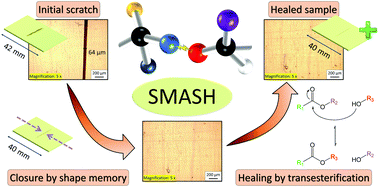Shape memory-assisted self-healing of dynamic thiol-acrylate networks†
Abstract
Self-healing polymers are tremendously attractive due to their ability to repair macroscopic damage and defects, thus opening doors to sustainable and reliable functional polymers. In this scope, vitrimers are in the spotlight, as dynamic polymer networks exhibiting unique properties such as self-healing ability, recyclability and malleability. The possibility of intrinsically healing macroscopic damage on the molecular scale repeatedly is undoubtedly appealing, although it would strongly benefit from an additional driving force bringing the surfaces of larger defects together. Herein, we present a study on the synergistic combination of physical and chemical healing of a thiol-acrylate vitrimeric photopolymer based on thermo-activated transesterification by pursuing a close-then-heal approach. By following shape-memory assisted self-healing (SMASH), we used the shape-memory properties of thiol-acrylate photopolymers to physically close a scratch, whilst chemical healing was obtained via thermo-activated dynamic exchange reactions of the –OH groups and ester moieties available in the network. We prepared formulations with varying thiol content and characterised their mechanical, chemical, and shape memory properties and healing efficiency. We provide a comprehensive picture of the role of physical recoil, bond exchanges and network mobility on self-healing efficiency as well as its limitations. By appropriate network design, defects with a size of 50–150 μm can be rapidly closed, and healing efficiency up to 90% can be reached in terms of ultimate tensile strength, thus demonstrating the potential of SMASH for vitrimers.

- This article is part of the themed collection: Photopolymer science


 Please wait while we load your content...
Please wait while we load your content...